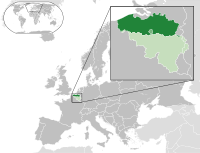| This article includes a list of references, related reading, or external links, but its sources remain unclear because it lacks inline citations. Please help improve this article by introducing more precise citations. (March 2019) (Learn how and when to remove this message) |


Westhoek (Dutch: [ˈʋɛstɦuk] , French: [wɛstuk]; Dutch for 'West Corner') or Maritime Flanders (French: Flandre maritime) is a region in Belgium and France and includes the following areas:
- Belgian Westhoek (Dutch: Belgische Westhoek) including the West Flanders arrondissements of Diksmuide, Ypres, and Veurne including the cities of Veurne, Poperinge, Wervik, Ypres, De Panne, Langemark-Poelkapelle, Diksmuide and Koekelare. However, the three Belgian coast municipalities of De Panne, Koksijde, and Nieuwpoort are frequently considered a separate region known as the Belgian or Flemish West Coast (Westkust).
- French Westhoek (French: Westhoek français; Dutch: Franse Westhoek), roughly the arrondissement of Dunkirk, including the cities of Dunkirk, Gravelines, and Hazebrouck, itself part of a larger area known as French Flanders.
Outside Dutch-language sources, Westhoek sometimes refers only to French Westhoek.
French Westhoek
See also: French FlandersGeography
French Westhoek is the northern part of French Flanders, lying between the river Lys and the North Sea on the Franco-Belgian border. It nearly corresponds with the Arrondissement of Dunkirk (the northwestern quarter of the Department of Nord) but with the some areas of the arrondissement falling outside Westhoek while some areas of traditional Westhoek lie in the neighbouring Department of Pas-de-Calais.
French Westhoek consists of three natural regions:
Blootland (Dutch for "naked land") or the Maritime Plain (French: Plaine maritime) including Dunkirk, Bourbourg, Bergues, and Hondschoote
Houtland (Dutch for "woodland"), including Wormhout, Cassel, Hazebrouck, and part of Bailleul
The Lys Valley (French: Vallée de la Lys or Plaine de la Lys; Dutch: Leiedal) including Merville, Steenwerck, and part of Bailleul
Language
The traditional language of French Westhoek is a Dutch dialect called West Flemish, the French subdialect of which is known as French Flemish. It was once the dominant language of the region, but a long-time policy of Francization, starting with the introduction of French as the language of education in 1853, has led to the replacement of Dutch with French in the region. Of the population of the approximately 380,000 inhabitants of French Westhoek, there are now between 10,000 and 20,000 daily speakers of West Flemish, many of whom live in the arrondissement and city of Dunkirk, and twice as many who occasionally use the dialect. Flemish was recently recognised as a regional language of France but there are no bilingual street signs and French remains the only official language in the area.

-
 Blootland country localization in France viewed by NASA Shuttle radar-imaging
Blootland country localization in France viewed by NASA Shuttle radar-imaging
-
 Westhoek map with historical language divisions and Dutch toponyms
Westhoek map with historical language divisions and Dutch toponyms
-
A street sign in Merck-Saint-Liévin, showing Germanic influence in local toponyms. The name Picquendal corresponds to the modern Dutch Piekendal.
The French Flemish dialect has had significant influence on local toponyms. For example, the French Westhoek towns of Robecq and Dunkirk are derived from the Flemish names of Robeke and Duinkerke.
Sources and references
- Ethnologue Report for West Flemish
- Flemish in France detailed overview
| Territories |
|  | ||||||
|---|---|---|---|---|---|---|---|---|
| Provinces (and cities) |
| |||||||
| Politics | ||||||||
| Symbols and history | ||||||||
| Other topics | ||||||||
50°54′N 2°36′E / 50.900°N 2.600°E / 50.900; 2.600
Categories: